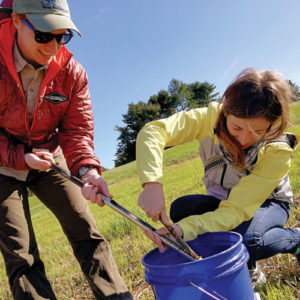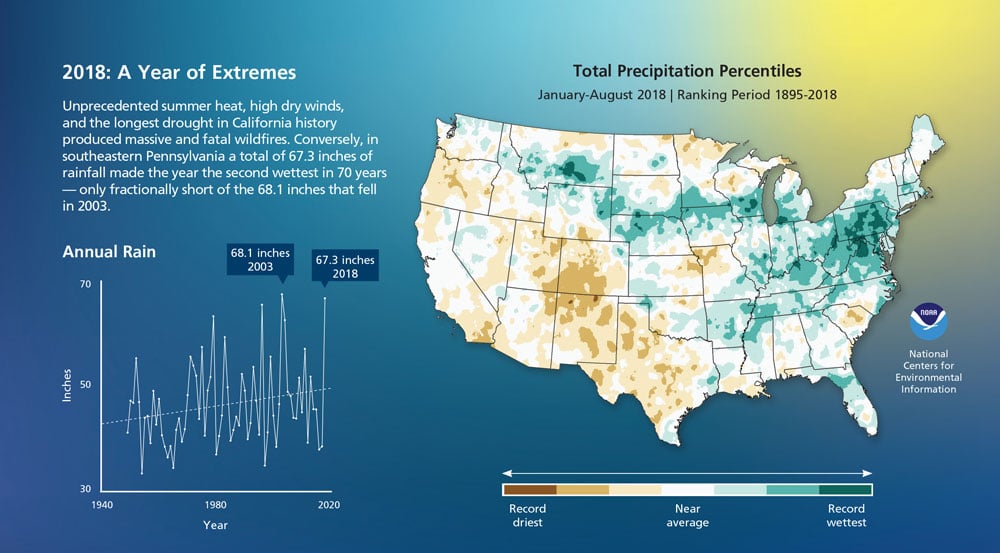Stroud Center Research in 2018
By James G. Blaine
All across America, 2018 was a year of extremes in weather, temperature, and precipitation, most notably and tragically in California, where unprecedented summer heat, high dry winds, and the longest drought in its history produced massive and fatal wildfires. Conversely, in southeastern Pennsylvania it was “water, water everywhere,” as a total of 67.3 inches of rainfall made the year the second wettest in 70 years — only fractionally short of the 68.1 inches that fell in 2003. “The long-term trend is real,” said Denis Newbold, Ph.D., research scientist emeritus, whose analysis of data from Stroud Water Research Center and nearby NOAA stations “suggests that average annual rainfall has increased by six inches since 1949.”
Yet unlike other years of heavy rainfall, 2018 had no major storms — the rain just kept falling. Among environmental scientists, there is little doubt that these weather extremes are related to changes in the earth’s climate.
Although water is one of the Stroud Center’s middle names, as well as its reason for being, too much of it can wreak havoc on its research projects — washing out experiments, intensifying runoff and erosion, and severely inhibiting the ability of its scientists to get onto the land and into the streams to do their work.
“It affects both the science you are trying to do and your ability to measure it,” said Senior Research Scientist John Jackson, Ph.D. “There was so much water in the Susquehanna River last year that we could not be in the river safely and get good data.”
For the farmers who own and work the land on which many of the experiments take place, the effects can be worse: washing away seeds, delaying planting and harvesting, stranding equipment, and leaving crops rotting in the ground. “If this kind of weather pattern becomes regular in the northeast,” said Watershed Restoration Coordinator Lamonte Garber, “conventional best practices in agriculture and watershed restoration will have to shift dramatically.”
Stroud Center scientists are engaged in three significant research projects aimed at creating and testing new land-management practices to address many of the issues raised by increased weather extremes. Their collective goal is to help us learn how to best mitigate flooding hazards and protect clean water in a future that will be defined by the still-unfolding impacts of climate change. “The good news,” said Garber, “is that — thanks to the unusually heavy rains in 2018 — we got lots of runoff data.”
Hurricane Sandy Project
The first project, known as the Hurricane Sandy Project, is funded by a $3 million grant from the National Fish and Wildlife Foundation. Named for the devastating 2012 storm that caused almost $70 billion in damage across the eastern United States and as far west as Wisconsin, the project’s aim is to reduce flooding by 40 percent across the 1,800-acre White Clay Creek watershed, while simultaneously improving the ecological health of the stream’s ecosystem. Now in its fourth year, the project has in place a number of flood mitigation best management practices (BMPs), including planting forest buffers along streams, creating floodplain wetlands, adding downed trees to stream channels, installing infiltration swales to capture field runoff, and terracing steep farm fields. Scientists are now in the process of comparing watershed flood responses before and after the BMPs were completed.
“In addition to reducing flooding risk,” said Melinda Daniels, Ph.D., the project’s lead scientist, “these practices should contribute to cleaner and cooler water, as more precipitation will soak into the ground and take a slow, chilled underground route to the stream, instead of flowing over the surface at air temperature. The net effect should be a cooler, healthier stream draining a watershed that produces lower magnitude floods during large storms.”
Multi-Species Cover Cropping
The second project is a three-year Conservation Innovation Grant from the U.S. Department of Agriculture, which Distinguished Research Scientist Bern Sweeney, Ph.D., completed in December. He is seeking to determine whether converting conventionally tilled farmland to no-till, multispecies cover cropping can maintain crop yields, improve soil health, reduce runoff and erosion, and decrease the flow of nutrients and chemicals into streams.
Preliminary results, said Sweeney, indicate that year-round cover cropping should help mitigate flooding because the improved soil structure will infiltrate and store rainwater longer, slowly releasing it through the ground, and ultimately into the stream. As a result, “there will be reduced runoff, and farmers will be less likely both to get their seed and soil washed away during rainstorms and need irrigation during droughts.”
For these kinds of large-scale, long-term research projects to produce meaningful results, researchers have to collect, process, and compare data over several years, and the Prince Albert II of Monaco Foundation recently agreed to provide an additional three-year grant. Sweeney and his colleagues will add a new twist to the project by eliminating seeds coated with neonicotinoid pesticides on select fields. Because plants take up only about 5 percent of the pesticide coating, the vast preponderance goes into the soil, air, and water, which has substantially increased the amount of toxins in the environment. Sweeney’s research will compare results between fields planted with neonicotinoid-treated seeds and those planted with organic seeds.
“What we’re doing really isn’t so new,” he said. “Somehow we got away from cover cropping, something our ancestors learned 7,000 years ago through trial and error, and came to rely instead on large engineering and irrigation projects, on synthetic fertilizers and disruptive dams, which are expensive and environmentally destructive. Cover cropping is a form of infrastructure: it reduces flooding and makes farming more sustainable.”
Healthy Soil, Clean Water

Finally, 2018 was the first year of a six-year, $6 million project funded by the William Penn Foundation in which researchers at Rodale Institute and the Stroud Center have joined forces to evaluate the impact of farming practices on soil health, water quality, agricultural productivity, and profitability throughout the 8.7 million-acre Delaware River Watershed. With systems ranging from conventional to conventional no-till to organic to organic no-till, the project’s goals, said Postdoctoral Researcher Raven Bier, are to “improve soil quality on the farms and water quality in the Delaware River watershed.” The extremely wet summer created challenges for farmers, ranging from delayed planting to mired equipment to lost crops, moldy hay, and excessive weeds, and these in turn seriously hampered the scientists’ efforts to gather background data. For example, said staff scientist Joey George, “infiltrometer tests require pouring water on the soil to look at how quickly it percolates. But the soils were so saturated that nothing percolated.”
In addition to research, the Stroud-Rodale project has programs for training farmers in the new techniques, engaging citizen scientists, and educating consumers.
All three studies seek to understand the impact of land-based activities, primarily by humans, on the quality and quantity of water and the life of streams. In doing so, they reinforce our understanding that all life is connected, and that what happens in one place has enormous — and often unintended — consequences for living beings and communities downstream. Like almost every other study in the Stroud Center’s 51-year history, each had its origins in the East Branch of White Clay Creek, a small third-order stream that runs beside (and even through) the Stroud Center.
Each study embodies the recognition that the best solutions for almost all water crises are not to undertake massive engineering schemes but, instead, to put watersheds and their streams in a position to fix themselves and then get out of the way — to, said John Jackson, “let nature take its course.”
“I call these ‘good neighbor projects,’” added Jackson. “They are aimed at mitigating damage to downstream communities, estuaries, and the ocean by reducing inputs at the source.” In years of unusual flooding, such as 2018, that becomes more difficult as the land gets saturated and the streams run high. With both the Stroud Center’s data and global climate models pointing to a future of increasing rainfall, both farmers and scientists are preparing to cope with more extreme weather conditions.
“There is a water crisis affecting both water quality and quantity,” said Sweeney. “It is local, regional, and global in scale. The solutions are going to come from people rolling up their sleeves and trying to figure things out locally, while always keeping the bigger picture in mind.”
This article was originally published in Stroud Water Research Center’s 2018 annual report. Become a Friend of the Stroud Center to receive a print copy of our annual report as soon as it is printed.




